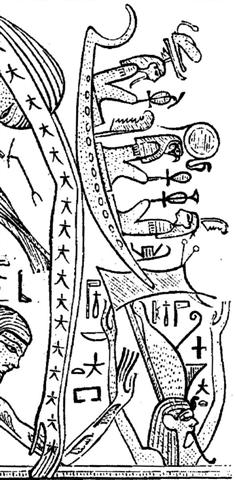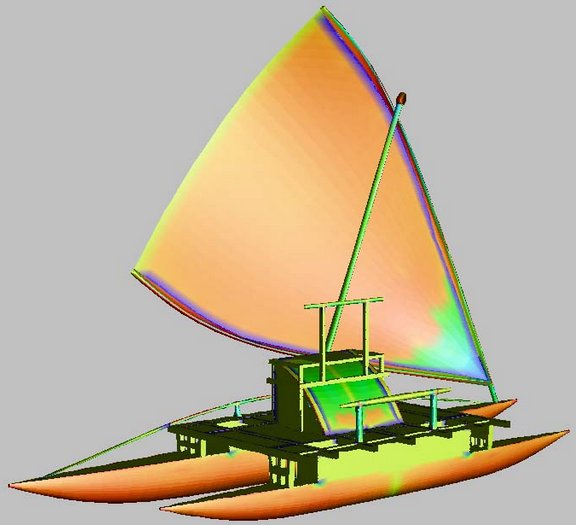Once again. Counting from day 158 (= *78 + 80) - when at the
time of rongorongo Rigel (matua tamaaroa) and Capella (matua
tamahahine) were truly heliacal - to the day when, at the time
of the Bull, Antares had returned to visibility - viz. in
SEPTEMBER 22 (265) there were 107 days.
265 (SEPTEMBER 22) - 16 (nights before a star returned to
visibility) = 249 (SEPTEMBER 6, when at the time of the Bull
Antares had been truly heliacal)
And 249 - 158 = 91, therefore 158 + 91 + 16 =
265.
Although 107 thus can be explained as a quarter + 16, it should
also to be noted that
107 = 1Ĺ * 314 - 364 = 80 (0h) + 27 (precessional depth down to
Roman times).
For people living south of the equator
Antares, Ana-mua, was the 'Entrance Pillar':

|
SEPT 20 |
21
(*184) |
EQUINOX |
23 |
24 |
25 (268) |
 |
 |
 |
 |
 |
 |
|
Ga7-14 |
Ga7-15
(184) |
Ga7-16
(740 / 4) |
Ga7-17 |
Ga7-18 |
Ga7-19 |
|
Heart-5 (Fox)
σ
Scorpii
(247.0),
HEJIAN = γ Herculis
(247.2),
ψ
Ophiuchi (247.7) |
ρ
Ophiuchi (248.1),
KAJAM (Club) =
ω
Herculis
(248.3),
χ
Ophiuchi (248.5),
SHE LOW (Market Tower) = υ Ophiuchi,
Tr.
Austr. (248.7), ζ Tr. Austr. (248.8) |
Al Kalb-16 (The Heart) /
Jyeshtha-18 (Eldest) /
ANA-MUA-1 (Entrance pillar)
ANTARES
= α Scorpii
(249.1),
MARFIK (Elbow) = λ Ophiuchi,
φ Ophiuchi (249.5), ω Ophiuchi (249.8) |
γ Apodis (250.1), σ Herculis (250.3), θ Tr. Austr.
(250.6), τ Scorpii (250.7) |
HAN = ζ Ophiuchi
(251.0) |
ζ
Herculis,
η
Tr. Austr.
(252.1), η Herculis, β Apodis (252.5) |
|
Mua.
Front, before; used with prepositions
a, i, o, ki, mai; i mu'a i.., in front of...,
etc. Vanaga. The front, that which comes foremost;
a mau [mua?], before, ahead, to
precede, come on, forward; kapu a mua, oho
a mua, to go ahead; i mua, before,
heretofore, preceding; i mua atu, sooner;
ki mua, at first, before, to go before; ko
mua, at first, then, otherwile; o mua a mua,
to march at the head; o mua roa, the first.
Churchill. |
|
"Oct 13 |
14 |
Tagaroa
Uri 15 |
16 |
17 (290) |
18 |
 |
At the time of Bharani - i.e. at a precessional depth of 23
right ascension nights later than the time of the Bull - the
Entrance Pillar would have been in day 265
(SEPTEMBER 22) + 23 = 288 ("October 15). This fact made me
assume Manuscript E was using the time-frame of Bharani, with
the Double-canoe of the Sun making Landfall at heliacal Antares
(at the time of Bharani).

Therefore, when in Vaitu Nui 25 the Explorers had left
their old homeland in order to search for Easter Island we
should
read "April 25 (115) - corresponding to day 115 + 41 = 156
(= 2 * 78, June 5) at the time of rongorongo.
The Explorers went in the night and at the time of rongorongo
the Full Moon would have been around night number 156 + 183 = 339
(= 600 - 261). This was evidently the place for Rongo:
| tagata tuu rima ki
ruga |
te maitaki |
te henua |
Rei
hata ia |
tagata
rogo |
|
... the first month of the
Moriori year, was named Rongo (Lono).
On the first of the new year the Moriori
launched a small canoe to Rongo, although
they built and used only rude craft for their
fishing excursions. The canoe was manned by twelve
figures symbolizing the personifications of the
twelve months. Sometimes twenty-four figures were
placed in the canoe, and Skinner interprets the
additional twelve as representing the female
counterparts of the months. As an old Maori once
remarked. 'Everything has its female counterpart
... |
 |
 |
 |
 |
 |
|
Ca3-21
(→ March 21 → Gregorian equinox) |
Ca3-22
(73) |
Ca3-23 |
Ca3-24 |
Ca3-25 (→ March 25→
Julian equinox) |
|
Hata.
1. Table, bureau. P Pau.: afata, a chest,
box. Mgv.: avata, a box, case, trunk, coffin.
Mq.: fata, hata, a piece of wood with
several branches serving as a rack, space, to
ramify, to branch; fataŠ, hataŠ,
stage, step, shelf. Ta.: fata, scaffold,
altar. 2. Hakahata, to disjoint;
hakahatahata, to loosen, to stretch. P Pau.:
vata, an interval, interstice. Mgv.: kohata,
the space between two boards, to be badly joined;
akakohata, to leave a space between two bodies
badly joined; hakahata, to be large, broad,
wide, spacious, far off. Mq.: hatahata,
fatafata, having chinks, not tightly closed,
disjointed. Ta.: fatafata, open. 3.
Hatahata, calm, loose, prolix, vast. Mgv.:
hatahara, broad, wide, spacious, at one's ease.
Ta.: fatafata, free from care. Mq.:
hatahata, empty, open. 4. Hatahata, tube,
pipe, funnel. Churchill. Sa.: fata, a raised
house in which to store yams, a shelf, a handbarrow,
a bier, a litter, an altar, to carry on a litter;
fatāmanu, a
scaffold. To.: fata,
a loft, a bier, a handbarrow, to carry on a bier;
fataki, a
platform. Fu.: fata,
a barrow, a loft; fatataki,
two sticks or canes attached to each other at each
side of a house post to serve as a shelf. Niuē:
fata, a
cage, a handbarrow, a shelf, a stage, (sometimes)
the upper story of a house. Uvea: fata,
a barrow, a bier. Fotuna: fata,
a stage. Ta.: fata,
an altar, a scaffold, a piece of wood put up to hang
baskets of food on; afata,
a chest, a box, a coop, a raft, a scaffold. Pau.:
fata, a
heap; afata,
a box, a chest. Ma.: whata,
a platform or raised storehouse for food, an altar,
to elevate, to support. Moriori: whata,
a raft. Mq.: fata,
hata,
hataŠ,
shelves. Rapanui: hata,
a table. Ha.: haka,
a ladder, an artificial henroost; alahaka,
a ladder. Mg.: ata,
a shelf; atamoa,
a ladder; atarau,
an altar. Mgv.: avata,
a coffer, a box. Vi.: vata,
a loft, a shelf; tāvata,
a bier. The Samoan fata
is a pair of light timbers pointed at the ends and
tied across the center posts of the house, one in
front, the other behind the line of posts; rolls of
mats and bales of sennit may be laid across these
timbers; baskets or reserved victuals may be hung on
the ends. The litter and the barrow are two light
poles with small slats lashed across at intervals.
The Marquesan fata
is a stout stem of a sapling with the stumps of
several branches, a hat tree in shape, though found
among a barehead folk. These illustrations are
sufficient to show what is the common element in all
these fata
identifications, light cross-pieces spaced at
intervals. With this for a primal signifaction it is
easy to see how a ladder, a raft, a henroost, an
altar come under the same stem for designation.
Perhaps Samoan fatafata
the breast obtains the name by reason of the ribs;
it would be convincing were it not that the
plumpness of most Samoans leaves the ribs a matter
of anatomical inference. Churchill 2. ...
Teke said to Oti, 'Go and take the
hauhau tree, the paper mulberry tree, rushes,
tavari plants, uku koko grass, riku
ferns, ngaoho plants, the toromiro
tree, hiki kioe plants (Cyperus vegetus),
the sandalwood tree, harahara plants, pua
nakonako plants, nehenehe ferns, hua
taru grass, poporo plants, bottle gourds
(ipu ngutu), kohe plants, kavakava
atua ferns, fragrant tuere heu grass,
tureme grass (Diochelachne sciurea),
matie grass, and the two kinds of cockroaches
makere and hata.'
... The division into quarters of a 28-series
can be applied to the main phases of the moon during
the visible period as was as to a (reflex of the old
world?) sidereal month.
The separate subgroup (29 makere - 30
hata) consists of the names of two types of
cockroaches, but in related eastern Polynesian
languages these names can also be explained on a
different level. MAO. makere, among others,
'to die', and whata, among others, 'to be
laid to rest on a platform', deserve special
attention. The
theme hinted at is one of death and burial. In our
scheme they occur at just that time when the moon
'has died'! This lends further support to the lunar
thesis. Barthel 2.
 |
|
CLOSE TO THE FULL
MOON: |
|
June
1 (152) |
2 |
3 |
4 |
5 |
|
π4
Orionis (72.1), οĻ Orionis (72.4), π5 Orionis (72.8)
*31.0 = *72.4 - *41.4 |
πĻ
Orionis (73.0), ο≤ Orionis (73.4),
HASSALEH
= ι Aurigae
(73.6), π6 Orionis (73.9)
*32.0 = *73.4 - *41.4 |
ALMAAZ
(The Male Goat) = ε Aurigae
(74.7),
HAEDUS I
= ζ Aurigae
(74.8) |
HAEDUS
II = η Aurigae
(75.9) |
5h
(76.1)
ε
Leporis (76.0),
CURSA
= β Eridani
(76.4), λ Eridani (76.7)
*35.0 = *76.4 - *41.4 |
|
DAY
72 |
73 (=
365 / 5) |
74 |
75 |
76 |
 |
|
CLOSE TO
THE SUN: |
|
Dec 1 |
2 |
3 |
4 |
5 |
|
Ophiuchi (255.3),
GRAFIAS
(Claws) = ζ Scorpii
(255.4) |
κ
Ophiuchi (256.2),
ζ
Arae (256.5),
ε
Arae (256.8),
CUJAM
(Club) = ε Herculi
(256.9) |
no star
listed (257) |
17h
(258.7)
ARRAKIS = μ Draconis
(258.7) |
Mula-19 (The Root)
SABIK
(The Preceding One) = η Ophiuchi
(259.7),
η Scorpii (259.9) |
 |
|
DAY
255 |
256
(= 4 * 64) |
257 |
258 |
259 |
| kua tupu te rakau |
kua tupu - te
kihikihi |
te hau tea |
 |
 |
 |
|
Ca4-1
(77) |
Ca4-2 |
Ca4-3 |
|
CLOSE TO THE FULL
MOON: |
|
μ
Aurigae, μ Leporis (77.6) |
ĸ
Leporis (78.0),
RIGEL
(Foot) = β Orionis
(78.1),
Flaming Star = IC405
(78.2),
CAPELLA
= α Aurigae
(78.4), ο Columbae, τ Orionis (78.8)
*37.0 = *78.4 - *41.4
THUBAN (α
Draconis)
|
λ
Aurigae (79.0), λ Leporis (79.6), ρ Aurigae (79.7)
ARCTURUS
(α Bootis)
|
|
June 6
(157 = 314 / 2) |
7 (*78) |
8 (4 *
29Ĺ + 41) |
|
DAY
77 |
78 (=
6 * 13) |
79 |
|
CLOSE TO
THE SUN: |
|
Dec 6
(340 = 157 + 183) |
7 (*261
= *78 + *183) |
8 |
|
DAY
260 |
261
(= 9 * 29) |
262 |
|











